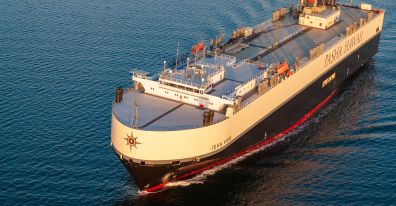Port of San Diego and The Pasha Group Achieve Major Clean Air Milestone

MV Jean Anne Becomes First Ro-Ro Vessel and Pure Car Carrier Commissioned for Shore Power in the U.S.
The Port added the single shore power plug at the National City Marine Terminal at a cost of $6.6 million, which includes $2.5 million in grant funding from the Volkswagen Environmental Mitigation Trust for California, administered by the California Air Resources Board.
All four of the Port’s marine terminals – two cargo facilities at the National City and Tenth Avenue Marine Terminals, and two cruise terminals at B Street and Broadway Piers – now have shore power available. In 2010, the Port of San Diego was among the first ports in the country to install shore power for ocean-going vessels.
Shore power systems support the Port’s Maritime Clean Air Strategy [1], which aims to improve environmental and public health through cleaner air while also supporting efficient, modern and sustainable maritime operations. Specifically, it supports the goal to reduce emissions from ocean-going vessels. It also advances the Port’s commitment to the California Air Resources Board’s (CARB) At-Berth Regulation that requires ro-ro vessels to utilize shore power or an exhaust capture control system, also known as a bonnet, which is a barge-based system that captures and filters air pollutants from the vessel’s stack while a ship is at berth. The National City Marine Terminal now has both a shore power and a bonnet system.
Pasha Automotive Services, the National City Marine Terminal operator, is a division of The Pasha Group [2], a family-owned company that has been operating at the Port of San Diego for 35 years. Pasha Automotive Services runs the most advanced vehicle import/export facility on the West Coast, importing and processing approximately 400,000 vehicles each year from Europe, Asia, and Mexico. Pasha Hawaii, a sister company, transports goods, equipment, and supplies on U.S.-flagged ro-ro and container ships between the U.S. and Hawaii.
The Port of San Diego is on the leading edge of adopting clean zero-emission technologies and equipment for maritime operations. Other “Port of Firsts” include:
-
First port in North America to have all-electric mobile harbor cranes.
-
First port in the country with an all-electric tugboat, which is operated by Crowley Marine.
-
Among the first ports to deploy a renewable powered microgrid system providing clean reliable power to the Tenth Avenue Marine Terminal.
-
First port on the West Coast with a tenant, Dole, to deploy battery-electric utility tractor rigs (UTRs) for cargo handling.
Since 2021, the Port and partners have committed more than $227 million toward maritime electrification and zero emissions initiatives resulting in decreased emissions since 2019. According to the Port’s 2024 Maritime Air Emissions Inventory, there has been a significant decrease in emissions compared to the 2019 Maritime Air Emissions Inventory:
-
46% reduction in diesel particulate matter (DPM) emissions.
-
32% reduction in nitrogen oxides (NOx) emissions.
-
10% reduction in greenhouse gases (CO2e).
